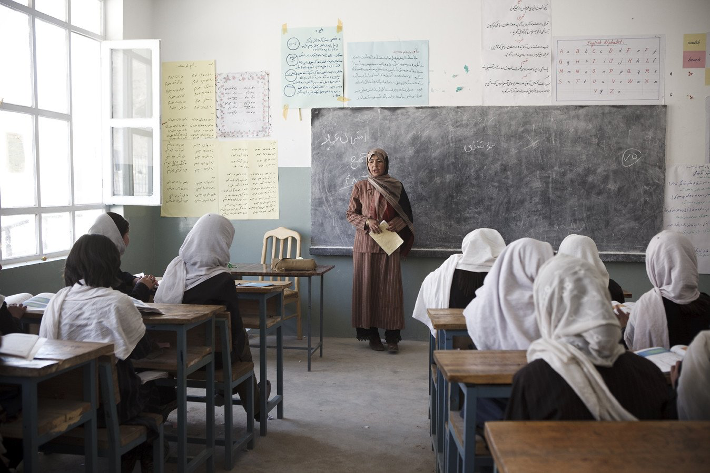Girls’ Education: 5 Shocking Facts Everyone Should Know
Girls are still being denied their right to a quality education

Join Global Citizen and share our app challenge to get every girl the education she deserves this World Education Day
The benefits of education are immense — for one, your ability to read and understand the rest of this article, among many other things. As a society, we recognize the crucial value of education and that’s why access to a quality education is a globally-recognized human right.
Decades of research have also shown that education is a major factor in the reduction of child mortality and poverty overall, as well as improving peace and stability. According to Malala Fund, when a country gives all its children secondary education, it cuts that country’s risk of war in half. Education also improves our capacity to contribute to our communities and gives us many much-needed tools to navigate an ever-changing world. Education is important, for everyone.
Now, while there are more girls going to school in the world today than ever before, the situation of girls’ education globally is still relatively dire — while the impact of COVID-19 has largely wiped out gains made in recent years. A recent World Bank report said: “Limited educational opportunities for girls, and barriers to completing 12 years of education, cost countries between $15 trillion and $30 trillion in lost lifetime productivity and earnings.”
But this doesn’t just impact countries, on the individual level, better educated women are more likely to be more informed about nutrition and health care, marry at a later age, and have fewer children — which are usually healthier than the children of less educated women. Such women are also more likely to participate in the labor market and earn higher incomes.
The longer this disparity in girls’ education exists, the more the world loses and many more girls will not have the opportunity to reach their fullest potential.
Change starts with all of us knowing the problem. So we’ve put together a list of some truly shocking facts about girls' education that should get you inspired to take action right now to put an end to this inequality. Buckle down.
1. Worldwide, 130 million girls are out of school.
That’s more than the population of the United Kingdom and France put together. According to the World Bank, “in low-income countries, secondary school completion rates for girls also continue to lag, with only 36% of girls completing lower secondary school compared to 44% of boys.”
2. Girls who have no education are three times as likely to marry by age 18.
More than 40 million girls aged 15-19 worldwide are married or in a union, according to Save the Children, and it’s estimated that 150 million more girls will be impacted by child marriage by 2030. Child marriage not only negatively impacts the lives of these girls, but also their children and ultimately, their countries.
Child brides are more likely to stop going to school, and experience early pregnancy, domestic violence, pregnancy complications, and malnourishment. Ending child marriage is one of the Global Goals and is a critical part of the fight to end extreme poverty.
3. 80% of people displaced by climate emergencies are female.
Extreme weather events, like many other global issues, disproportionately affect women and girls, which in turn has serious implications for girls’ education. Displacement caused by climate disasters has been linked with early marriage, school drop-outs, and teen pregnancies, according to the UN’s child agency UNICEF.
On the flip side, the Global Partnership for Education (GPE) estimates that for every additional year of schooling a girl receives, her country’s resilience to climate disasters improves, indicating increased economic, governance, and social readiness to cope with climate change-related events.
4. Girls living in conflict and crisis areas are 90% more likely to be out of school.
According to Education Cannot Wait, girls who are facing conflict and crisis are 90% more likely to be out of school than girls in a non-crisis environment. Girls in these areas are also often unable to access critical health, educational, and social protections, and the World Bank estimates that girls are 2.5 times more likely to be out of school than boys in areas experiencing conflict or crisis. The situation is worse in some places than others. A recent example is Afghanistan, where girls have been banned from attending any schools or university.
“Girls in Afghanistan not only face challenges in returning to school, but the collapse of the economy, and the financial pressure from their parents and themselves,” UNICEF Director of Education Robert Jenkins told Global Citizen in 2022.
5. 60 million girls are sexually assaulted on their way to or at school every year.
Sexual assault and violence has serious consequences for girls accessing and completing education. It also affects their mental and physical health and overall well-being, while also leading to lower school attendance and higher dropout rates, according to the World Bank.
Furthermore, school-related gender-based violence, which can result in adolescent pregnancies, stigma, and discrimination, affects an estimated 246 million children worldwide.
“If every girl received 12 years of schooling, child marriage would plunge by two-thirds, and girls’ higher lifetime earnings would grow economies by as much as US$30 trillion,” the GPE said in a recent report — highlighting the immense benefits the world stands to gain from paying attention to, and investing, in girls’ education.
We must not give up on the millions of girls around the world who are being deprived of their human right to education, and unite to call on leaders across every level to prioritize education for girls. Join Global Citizens around the world today who are taking action to stand up for girls’ education by completing the World Education Day Challenge in the Global Citizen app.

